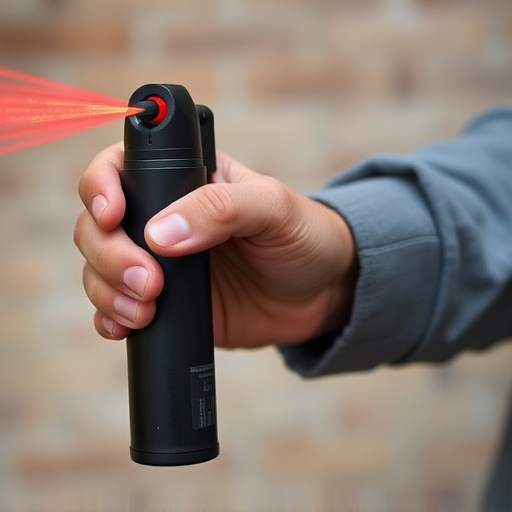Crowd control pepper spray techniques, like oleoresin capsicum (OC) spray, are crucial tools for law enforcement, offering safe and effective solutions in managing large gatherings. Optimal deployment requires strategic assessment of crowd dynamics, proper training on various spray types and de-escalation methods, and the use of protective gear. Legal and ethical considerations govern its application, with strict guidelines ensuring proportionate force during public disturbances while upholding individual rights and freedom of assembly. Advanced spray formulas cater to specific environments, reflecting ongoing efforts to refine crowd control strategies.
“In situations requiring crowd management, police often turn to crowd control pepper spray as a crucial tool. This strategic guide explores the multifaceted topic of Crowd Control Pepper Spray Techniques. From understanding crowd behavior and ensuring pepper spray safety, to delving into various types of agents and deployment strategies, this article offers an in-depth look. We also examine legal considerations and ethical implications, providing essential insights for effective and responsible use. By mastering these techniques, law enforcement can navigate challenging scenarios with enhanced control and minimal harm.”
- Understanding Crowd Behavior and Pepper Spray Safety
- Different Types of Pepper Spray for Crowd Control
- Effective Deployment Techniques and Best Practices
- Legal Considerations and Ethical Use of Pepper Spray in Crowd Control
Understanding Crowd Behavior and Pepper Spray Safety
Understanding crowd behavior is a critical aspect of effective crowd control, especially when employing pepper spray techniques. Crowds can exhibit unpredictable dynamics, influenced by factors like size, density, and emotional states. During high-density gatherings, individuals may act differently than they would alone, often becoming more impulsive and reactive. Police officers must be adept at assessing these situations to deploy crowd control measures appropriately. Pepper spray, a common tool in such scenarios, should be used judiciously, as its effects can vary greatly depending on the crowd’s composition and the environment.
When considering pepper spray safety, it’s crucial to recognize that while effective for crowd dispersion, it also poses risks. Exposure to pepper spray can cause temporary blindness, difficulty breathing, and severe discomfort, especially in individuals with pre-existing respiratory conditions. Proper training ensures officers understand safe application methods and know how to respond to potential off-target effects or misuses. Additionally, keeping up with advancements in non-lethal crowd control technologies is essential, allowing for diverse strategies that balance public safety with minimal harm.
Different Types of Pepper Spray for Crowd Control
In the arsenal of crowd control techniques employed by law enforcement, pepper spray stands out as a versatile and effective tool. It comes in various forms tailored to different scenarios and needs. One common category is oleoresin capsicum (OC) spray, which contains a potent extract from chili peppers. This type is popular due to its quick knockdown effect and relatively short duration, making it suitable for controlling large gatherings or aggressive individuals.
Beyond OC spray, specialized formulas target specific crowd control objectives. For instance, some pepper sprays include additives designed to reduce wind blowback, ensuring better visibility for both officers and suspects in open-air situations. Others may incorporate ingredients that enhance the spray’s stickiness, allowing it to remain on surfaces or individuals longer, which can be crucial in confined spaces. These variations reflect the dynamic nature of crowd control operations and the continuous efforts to refine police strategies using advanced pepper spray techniques.
Effective Deployment Techniques and Best Practices
Effective crowd control pepper spray techniques require a strategic approach and adherence to best practices. Law enforcement officers should first assess the crowd’s behavior and size, determining the appropriate amount and method of deployment. Targeting key individuals within the crowd, such as agitators or leaders, can help disrupt and disperse the group more efficiently. Spraying from a safe distance ensures minimal risk to bystanders while maximizing its impact on the targeted area.
Proper training is vital for officers to ensure they use pepper spray responsibly and proportionately. This includes understanding different types of pepper spray, their effects, and how to manage potential de-escalation scenarios. Officers should also be equipped with personal protective equipment (PPE) to safeguard against potential cross-contamination and maintain their visibility during deployment.
Legal Considerations and Ethical Use of Pepper Spray in Crowd Control
The legal and ethical aspects of employing crowd control pepper spray are complex and require careful consideration. In many jurisdictions, law enforcement agencies are permitted to use pepper spray as a non-lethal force option during demonstrations or public disturbances where crowd management is essential. However, its usage is subject to specific guidelines and regulations that vary across regions.
When utilized appropriately, crowd control pepper spray techniques can help de-escalate tense situations, allowing for better control and the safety of both officers and protesters. Yet, the ethical implications are significant. The potential for misuse or excessive force must be mitigated through thorough training and strict protocols. Law enforcement must balance the need to maintain public order with preserving individual rights and freedom of assembly, ensuring that crowd control measures remain proportionate and respectful of human dignity.
In conclusion, understanding crowd behavior and implementing safe, effective crowd control pepper spray techniques is essential for law enforcement. By choosing the right type of pepper spray, employing best practices, and considering legal and ethical guidelines, officers can ensure public safety while minimizing harm. These strategies form a robust framework for managing large gatherings, making them invaluable tools in modern policing.
